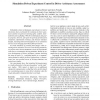Free Online Productivity Tools
i2Speak
i2Symbol
i2OCR
iTex2Img
iWeb2Print
iWeb2Shot
i2Type
iPdf2Split
iPdf2Merge
i2Bopomofo
i2Arabic
i2Style
i2Image
i2PDF
iLatex2Rtf
Sci2ools
DSRT
2008
IEEE
2008
IEEE
Simulation Driven Experiment Control in Driver Assistance Assessment
Embedded systems technologies and advances in micro electronics have accelerated the evolution of driver assistance systems towards more driving safety, comfort, entertainment and wayfinding. With the technological and quality progress, however, also goes the growing of interaction complexity, information overload, and intricate interface designs. Assessing interaction designs for in-car assistance services is an emerging and vibrant field of research. To avoid situations of possibly fatal danger when assessing driver assistance services in real driving situations, we propose trace-driven simulation to steer the experiments with users in a automotive driving simulator. Based on our own developments of driver assistance systems involving the sense of touch, i.e. exploiting haptics as a communication channel in vehicle-to-driver interactions, we demonstrate how pre-recorded traces of driving situations can control user studies. Our experiments show, that simulated driving journeys is ...
Driver Assistance | Driver Assistance Systems | Driving Situations | DSRT 2008 | Modelling And Simulation |
| Added | 29 May 2010 |
| Updated | 29 May 2010 |
| Type | Conference |
| Year | 2008 |
| Where | DSRT |
| Authors | Andreas Riener, Alois Ferscha |
Comments (0)

